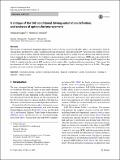A critique of the SAE conditional driving automation definition, and analyses of options for improvement
Author(s)
Sheridan, Thomas B
Download10111_2018_Article_471.pdf (943.4Kb)
PUBLISHER_CC
Publisher with Creative Commons License
Creative Commons Attribution
Terms of use
Metadata
Show full item recordAbstract
The Society of Automotive Engineers defines five levels of driving automation (LoDA) (plus a “no-automation” level 0). Among them, the third level, called “conditional driving automation,” here denoted LoDA 3, performs the complete dynamic driving task (DDT) within a limited operational domain. Although the driver is free from any driving task while the automation is engaged, she is expected to be receptive to an automation-issued request to intervene (RTI) and is also expected to perform DDT fallback in a timely manner. This paper gives a method to derive an optimal design for RTI and proves that LoDA 3 coupled with the optimal RTI should never be simply called “conditional driving automation.” This means that the definition of LoDA 3 is not complete and that at least one important level is missing in the list for LoDAs. This paper provides two ways to resolve the problem. Keywords: Automated driving; Levels of driving automation; Request to intervene; Levels of automation; Trading of authority; Shared control
Date issued
2018-02Department
Massachusetts Institute of Technology. Department of Aeronautics and Astronautics; Massachusetts Institute of Technology. Department of Mechanical EngineeringJournal
Cognition, Technology & Work
Publisher
Springer London
Citation
Inagaki, Toshiyuki and Thomas B. Sheridan. “A Critique of the SAE Conditional Driving Automation Definition, and Analyses of Options for Improvement.” Cognition, Technology & Work (February 2018): 1-10 © 2018 The Author(s)
Version: Final published version
ISSN
1435-5558
1435-5566